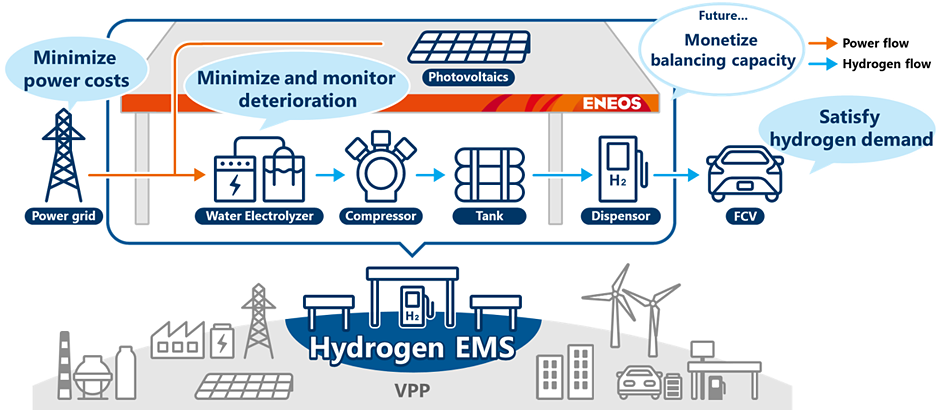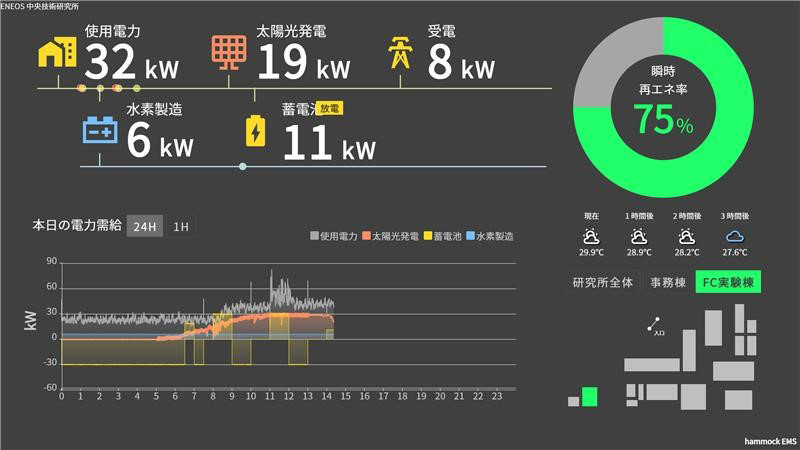Energy Management Technology
Renewable energy sources such as solar power and wind power have been introduced for building the decarbonized society. However, since the output of renewable energies fluctuates due to weather conditions, it becomes difficult to balance the supply and demand of electricity as the spread of renewable energies.
At present, the supply-demand balance is maintained by adjusting the output of thermal power and pumped storage power. In order to introduce more renewable energies, there is a lot of technological development going on to adjust the supply-demand balance using various devices.
For example, DR (demand response) is a technology that controls power-consuming devices such as air-conditioner and storage batteries in accordance with the supply and demand of electricity. In addition, VPP (Virtual Power Plant) is a technology to control scattered devices such as solar power generators and household storage batteries together to make them appear as if they were a huge power plant.
ENEOS is engaged in the electric power and hydrogen businesses and has many power generation and storage facilities as well as hydrogen production facilities. Therefore, we can contribute to the spread of renewable energy by applying the above technology. In addition, we are developing our own energy management technology to optimize the operation of our facilities according to the demand for electricity and hydrogen, market prices, and the characteristics of the facilities.
Forecasting technology
It is important to create operational plans based on accurate forecasts of renewable energy generation, electricity and hydrogen demand, and electricity market prices in order to optimize the operation of each facility.
For each of these forecasting technologies, we evaluate external technologies and develop forecasting systems in-house. For example, in the field of solar power generation forecasting, we have developed a highly accurate forecasting method that combines an engineering method for predicting power generation based on the characteristics of the power panels and installation conditions, and an AI-based method for forecasting based on past power generation. We are implementing such technologies in a variety of projects.
Energy Management Technology Using Hydrogen
Hydrogen can be produced by electrolyzing water and can be stored. Therefore, hydrogen production can contribute to stabilize the power system when there is a surplus of renewable electricity. Water electrolyzers can quickly respond to operating commands, so they can be useful to keep the grid frequency. Furthermore, hydrogen can be reconverted into electricity by fuel cells, hydrogen gas turbines, etc., so that stored hydrogen can be used to generate electricity in times of renewable energy shortages or emergencies.
Taking full advantage of these characteristics of hydrogen, we have developed an energy management technology to simultaneously optimize the supply and demand of electricity and hydrogen and to economically operate each facility. Since fiscal year 2022, our Yokohama Asahi Hydrogen Station has been operated using this system. The control of the equipment is optimized by a python program developed by our team members, and the program is being improved on a routine basis.

Demonstration Platform System: hammock™
The Central Technical Research Laboratory has various energy devices such as solar power generation systems, storage batteries, water electrolyzers and EV chargers. We have developed a system on the cloud to monitor and control all of these facilities by connecting them to the Internet. By using this system, newly devised operation algorithms can be quickly applied to actual equipment as demonstration tests.

Technology Stack
In developing in-house services, we always challenge ourselves to incorporate cutting-edge technologies and try to select the most appropriate technology stack.
Table Examples of Technology Stacks (as of December 2022)
| Backend | Python (FastAPI) |
|---|---|
| Optimization | PuLP, Gurobi |
| Machine Learning | Python, scikit-learn, LightGBM, Optuna, MLflow |
| Infrastructure | AWS, serverless framework |
| Database | AWS RDS (PostgreSQL, Aurola serverless), AWS DynamoDB |
| Environment | VSCode (devcontainer), docker |
| Code Management, CI/CD | GitHub, GitHub Actions |